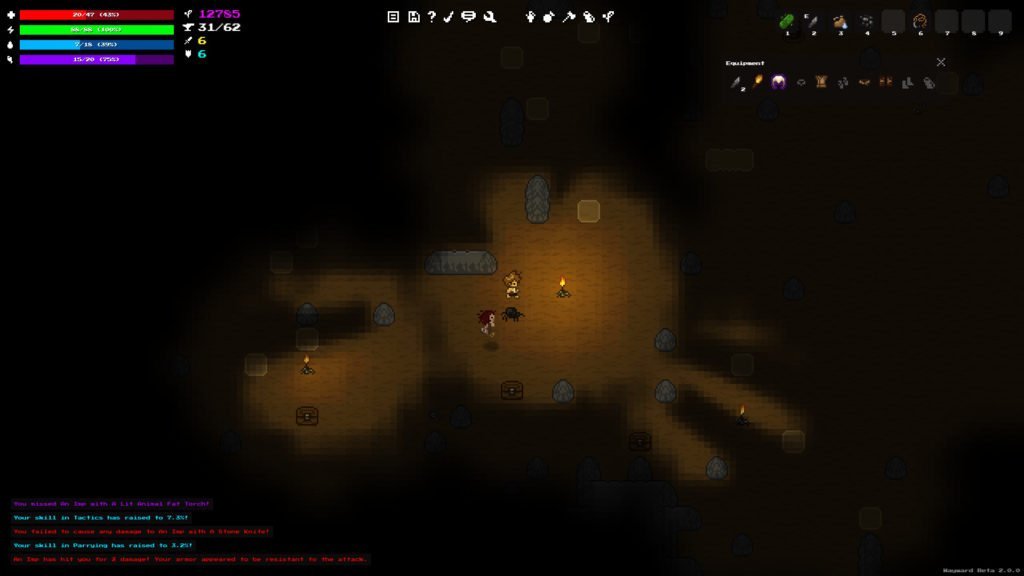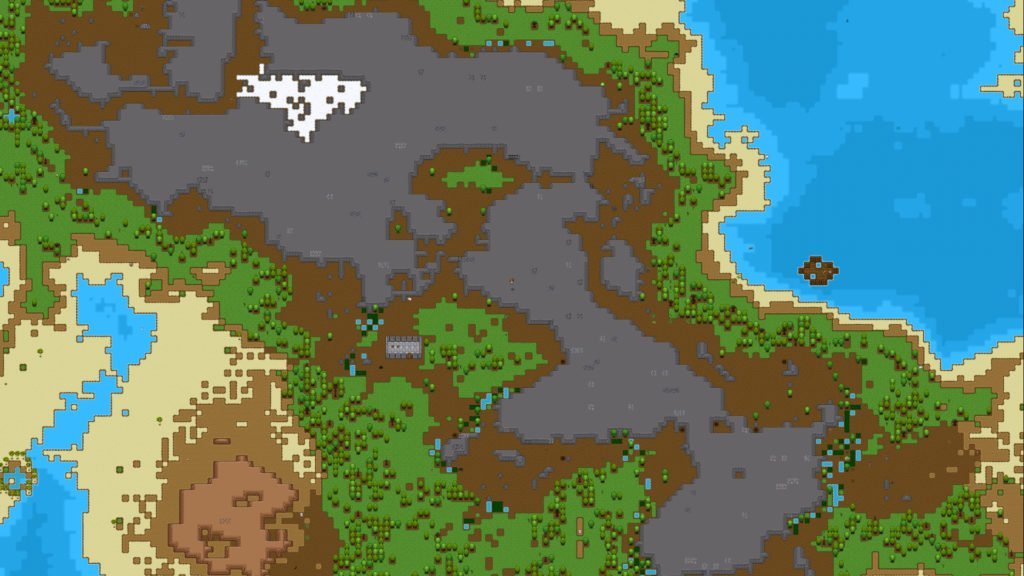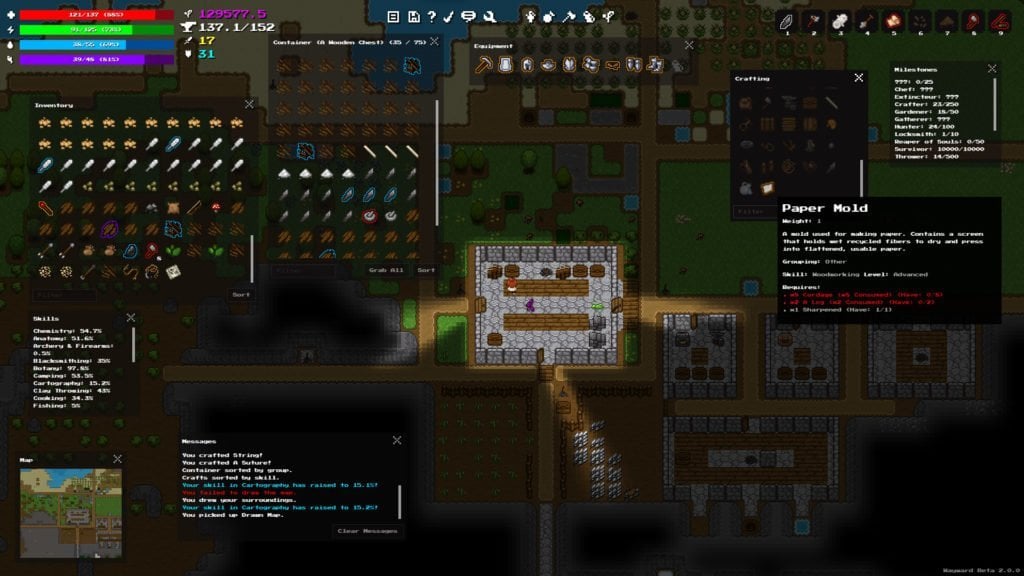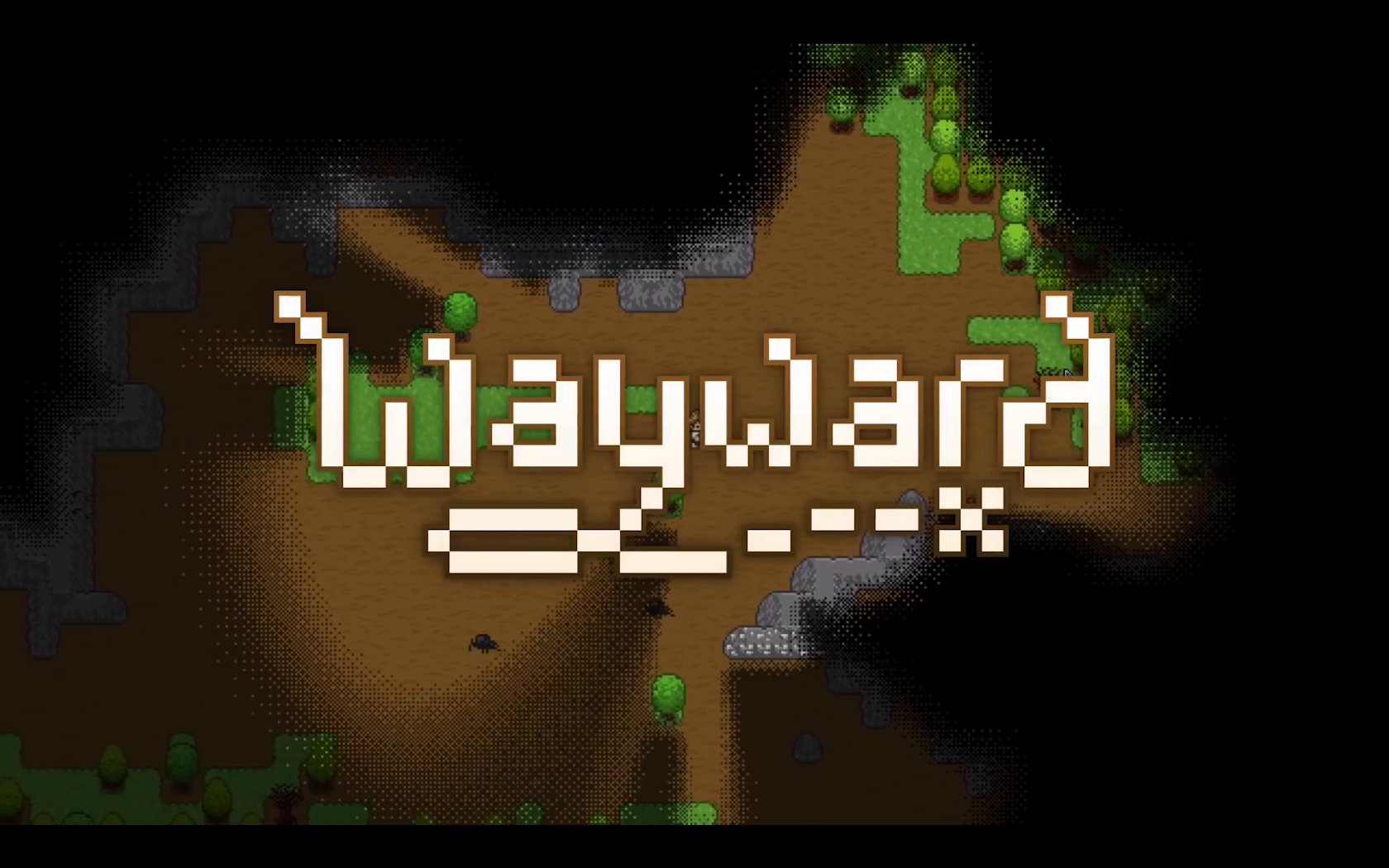Wayward is a turn based top-down wilderness survival roguelike. And so far, the only main flaw is how hard it is to remember that full genre.
Developed by Unlok, Wayward Beta 2.0 was released on Steam April 22nd. A free version of the game, pre 2.0, can be found here to play in your browser. Unlok decided to give players a taste of what Wayward is actually like without restricting the experience in a demo.
Wayward’s story, although not very integrated into the game, sees you stranded on an island. Your inventory is full of only a small assortment of items (which are randomized), and you must fight for survival.
Unlike crafting-centric games like Minecraft or Terraria, Wayward’s main objective is collecting resources for survival over crafting an impressive house. The latter comes in eventually, but it’s an uphill battle from the moment you land on the island. You have to watch your Health, Stamina, Thirst, and Hunger to keep yourself alive. On top of basic survival stats, you also only have a certain amount you can carry before becoming encumbered. Exceeding your limit makes your stamina drain much faster than it normally would.
You also get different effects from your surroundings. If you walk through a camp fire you’ll be burnt, and the pain will take awhile to subside, slowly draining your health away. When fighting a venomous animal, like a spider, you can get poisoned. When fighting animals like rats, you can start bleeding. All three of these effects require unique cures. Going for a swim in the ocean will help with a burn, while you’ll have to craft some medicinal water for poison.

Although the game has useful hints and tells you how to cure each effect, you won’t always have the items to fix the problem. And if you don’t get them fast enough you’ll end up dying, and starting all over again.
The crafting doesn’t require you to shove random items into a box and hope it works. Instead, you must unlock patterns throughout your adventures in Wayward. After death, the only thing that survives is your crafting recipes. All of the items you have gathered up and squirreled away are gone, and you must start fresh.
This makes the game frustratingly difficult, with a ‘Hardcore’ mode required for anyone who wants to try it out. Still, Wayward is trying to be a hardcore survival game, and it has done that surprisingly well in just Beta 2.0.
Anytime you load up a new character in Wayward you have the option to play through the beginner quests. It walks you through the basics: gathering supplies, getting clean water, and building shelter. If you don’t build shelter before night comes you will have to fight off enemies, increasing the games difficulty.
With a roguelike map each time, Wayward’s islands may feel small to start, but it soon becomes pretty obvious that they aren’t. Depending on what kind of island you end up with, it can make the game more difficult for the first few days. From finding random shelter to actually having a large harvest of stone on the island, it all depends on how experienced you are with the game and how you utilize your surroundings.

When gathering supplies in Wayward you’ll have to find equipment that is proficient in gathering the specific type of materials you need. Axes are better on wood, hammers on stone, and so forth. If you try to use something that is not proficient you will have a hard time gathering the needed supplies. If you try to do it barehanded, you even have a chance of taking damage.
After gathering a necessary stockpile of supplies, you’ll begin crafting new items. You’ll need gathering tools – to replace those you broke – and water stills, as well as a safe place to sleep.
With the focus placed on survival, the crafting in Wayward is the most straight forward part of the game. Gather supplies, and then click on the recipe you wish to attempt. Depending on how new you character is to crafting, the attempt might fail, or it might succeed. The number of times you fail then affects the durability of the item you were trying to craft.
Throughout your survival adventure, you can level up multiple skills. Crafting, technique(used in fighting), and camping are just some of the things you’ll have to hone. As you level them up, all of the processes become easier, and new crafting recipes become available. Certain recipes have different levels, so you’ll want to avoid the higher ones early on in the game.
Some of the supplies you’ll need require you to go and fight enemies found around the island. It can be difficult to find the specific type of animal that drops the supplies you need during the day, and when you do find them there’s no guarantee you will even win the fight. You’ll be left to either run for your life, or die trying.
A unique and perhaps advantageous design to Wayward is that once you die, you’re dead forever. The only thing that you keep are the crafting recipes you may have picked up or learned over time. Although this can be frustrating to many players, it gives Wayward an edge that most other crafting or survival games don’t have: difficulty.

By creating an environment that is actually difficult to survive in, players are challenged in ways that most games don’t provide anymore. Games with difficulty like Wayward aren’t something you find anymore, and it’s fantastic to see developer Unlok trying to get that across in his new game. I’ll be excited to see how they continue to balance the game as it gets closer to a full release.
If you’re looking for an up and coming easy game, this certainly isn’t it. But don’t let that discourage you from picking up Wayward – just be prepared for a lot of frustration.
Wayward is currently in Beta 2.0, and is available on the Steam Store for $7.99 USD
You can follow developer Unlok and Wayward on Twitter.


